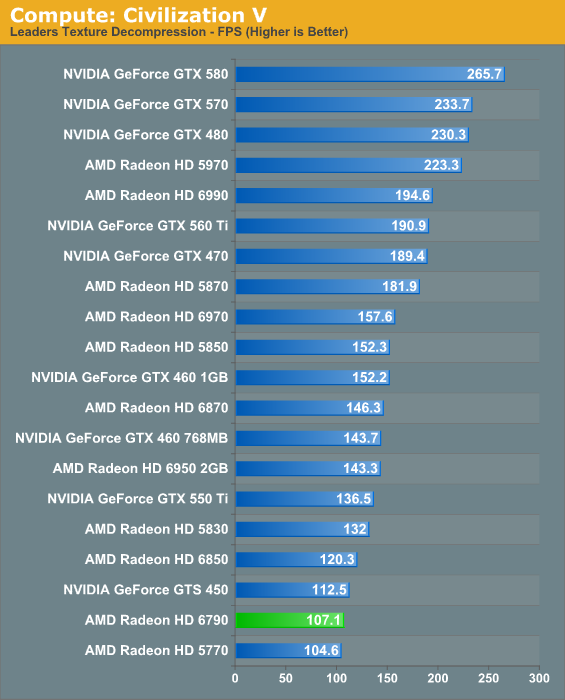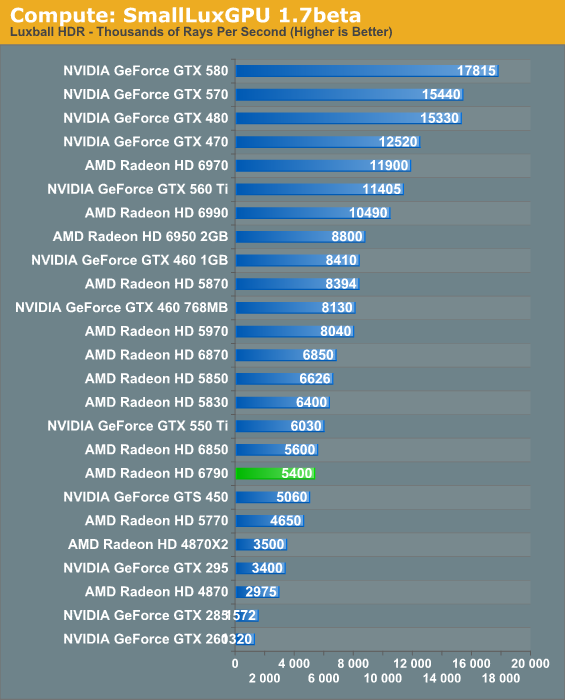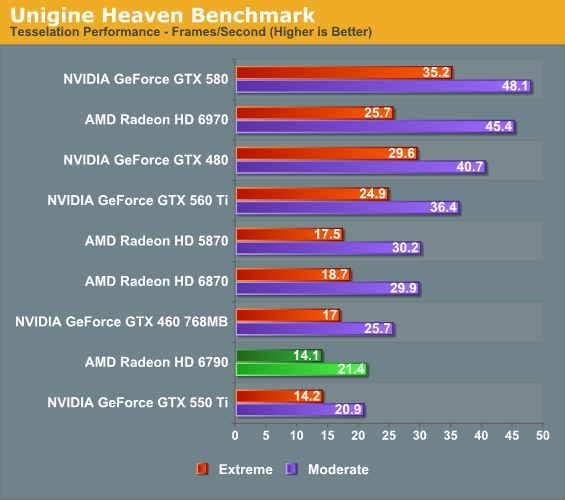AMD's Radeon HD 6790: Coming Up Short At $150
by Ryan Smith on April 5, 2011 12:01 AM ESTCompute & Tessellation
Moving on from our look at gaming performance, we have our customary look at compute performance, bundled with a look at theoretical tessellation performance.
Our first compute benchmark comes from Civilization V, which uses DirectCompute to decompress textures on the fly. Civ V includes a sub-benchmark that exclusively tests the speed of their texture decompression algorithm by repeatedly decompressing the textures required for one of the game’s leader scenes.

Civilization V’s compute benchmark cares little for memory bandwidth or the architectural differences between Barts and Juniper; SPs and clockspeed are what matter here. As a result the 6790 narrowly averts a tie with the 5770 of all things, and the performance relative to NVIDIA’s cards isn’t any better.
Our second GPU compute benchmark is SmallLuxGPU, the GPU ray tracing branch of the open source LuxRender renderer. While it’s still in beta, SmallLuxGPU recently hit a milestone by implementing a complete ray tracing engine in OpenCL, allowing them to fully offload the process to the GPU. It’s this ray tracing engine we’re testing.

SmallLuxGPU ends up being one of the best showings for the 6790, as while it’s obviously compute bound, it definitely benefits from the architectural differences between Barts and Juniper. The 6790’s performance relative to the 6850 almost identically matches the theoretical performance difference, and in spite of the 5770 having a slight theoretical advantage of its own, the 6790 easily beats the 5770 by 16%. This opens up a small window for the 6790 as a lower-priced GPGPU product, but it’s a very small window – the program would need to excel on AMD cards and on Barts over Juniper. Otherwise we see SLG where the 6790 does well versus the 5770, but very poorly compared to NVIDIA’s cards.
At the other end of the spectrum from GPU computing performance is GPU tessellation performance, used exclusively for graphical purposes. Barts’ tessellation improvements should give it an edge over the 5770, but it still has to contend with the 6800 series.


At this point in time none of our games closely match our tessellation results, which shouldn’t be a surprise given the low usage of tessellation. Although Barts isn’t a tessellation monster it could do quite well in the future if tessellation takes off in a manner similar to how these benchmarks use it, but that’s a very big if.










69 Comments
View All Comments
SquattingDog - Tuesday, April 5, 2011 - link
"it's LEANING from the past..." should be it's LEARNING from the past. Otherwise a great article, very speedily put out. Looks to be an interesting card, depending on what pricing it is available at here. Of course the 6850/6870 are much better and the 6850 looks to be better bang for buck, but when people cannot squeeze a few extra bucks out of the wallet, it should be pretty reasonable. Especially once the GTX460s are out of circulation, which is bound to happen soon enough.Glad to see more competition and finally some products reaching further down in the retail sector not just OEM from AMD.
ZL1Corvette - Tuesday, April 5, 2011 - link
2nd to last page possible typo:"Last but not least as always is our look at the power consumption, temperatures, and acoustics of the GTX 550 Ti."
Did you mean 6970?
ZL1Corvette - Tuesday, April 5, 2011 - link
See, we all make mistakes. I meant 6790.stm1185 - Tuesday, April 5, 2011 - link
800 Stream Procs, 40 Texture Units, 16 ROPs, 256 bit memory bus. Only the 6970 has a 840mhz clock compared to 750 mhz, and 1050mhz on the memory compared to 900mhz on the 4870.My card has held up well it seems.
james.jwb - Tuesday, April 5, 2011 - link
I have a 4890 with a 2560x1440 screen, and to my surprise, i can play quite a few games at 30fps, and most older ones at 60+fps. Like F1 2010, around 50fps.What a card, eh?
WhatsTheDifference - Tuesday, April 5, 2011 - link
hello. nice card. I play everything at 19x12 with my 4890 (in this case, an msi cyclone soc) with never a problem of any kind. it bloodies the 285's face.kind of a wondrous thing, then, that anandtech.com has banned the 4980 from all benchmarks...ain't it? XD
B3an - Wednesday, April 6, 2011 - link
*rolls eyes* ... They dont have any 2xx series here either. The ATI 4xxx and NV 2xx series do not belong here.If you want to see how your 4890 stacks up simply go the the GPU Bench page to compare.
WhatsTheDifference - Saturday, April 9, 2011 - link
what would you say these are, at least at first sight?NVIDIA GeForce GTX 295
NVIDIA GeForce GTX 285
NVIDIA GeForce GTX 260 Core 216
and
AMD Radeon HD 4870X2
AMD Radeon HD 4870
......?
please make your way to 'index' and 'the test'. or, maybe I'm confusing articles.
now adding the always-juvenile *rolls eyes*
pandemonium - Tuesday, April 5, 2011 - link
Gotta take the bad with that good though.Both the 4870 and 4870x2 run much hotter and take a butt load more power to produce lower framerates. And the 4870 was never a lower tier card by any means. Plus, no DX11 support on the 4870. Not that it's incredibly important, but just another note.
I'd say this is a good example of hardware evolution.
edpierce - Tuesday, April 5, 2011 - link
I disagree. Recent video card innovations have been real unimpressive lately. It really does seem like we are not much further than 3 years ago in terms of visual video card performance. Are we hitting a massive roadblock here?